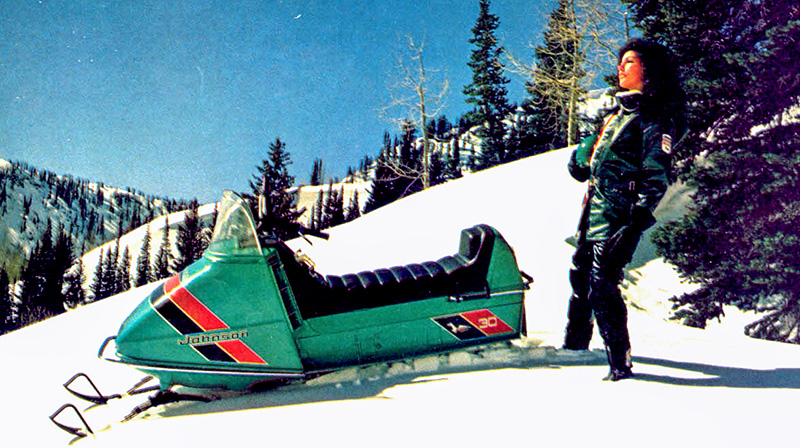Conceived by engineer and racecar driver Francois Favreau, the Buzz snowmobile was introduced by Autotechnic Inc., of Montreal, Quebec, for the 1970 snow season. Built in St.-Pie-de-Bagot, Quebec, the Buzz had a riveted aircraft aluminum chassis, mid-mounted Sachs engine, disc brake and bogie wheel suspension, and was available in red, yellow, orange, blue or green.
But the Buzz didn’t last. It was almost immediately re-christened as the Ski-Zoom. And a new Kohler-powered green and gold version called the Sno-Pack went into production for distribution in the United States by Leisure Mor, Inc., of Green Bay, Wisconsin. Private branding agreements like this were common, and Autotechnic was joining many other snowmobile companies in this process.

Meanwhile, Ski-Zoom was gaining acceptance by the Quebec snow machine press. “After driving other snowmobiles, getting into a Ski-Zoom is like going from a Chevrolet Impala to an
Alfa-Romeo GTV,” wrote Jaques Duval in the March, 1970, issue of the French magazine Vroum Motoneige.
Misreading The Tea Leaves
Under guidance of businessman President Simon Bedard, Autotechnic was a recreational manufacturer on the rise. Convinced that the booming snowmobile market was headed for the often-predicted sales of 1 million machines per year, and buoyed by the quick acceptance in the Quebec market, the company continued to invest in new product despite early signs of trouble.
Three new Ski-Zoom models were introduced for 1971, the entry-level Rebel, the mid-market Comet and the high-performance Fury. All sported a new hood design and were done in the orange over black that would become the brand’s signature color scheme. But underneath nothing much had changed, and the 1971 lineup also included what were essentially left over 1970 models to use up the multi-colored hoods and excess Kohler engines from building the Sno-Pack.
That alternate brand deal was history as Leisure Mor had sold out to Farmington Engineering in Michigan, and that company was building its own sleds under the Sno-Pac label (note the spelling change). Ski-Zoom also entered the costly world of snowmobile competition with a short run (fewer than 100 units) of factory racers that accomplished essentially nothing.
However, like many other snow sled manufacturers, Autotechnic added a series of six mini-bikes under the Mini-Zoom banner, and pressed ahead with sled development including consolidation of operations within a 100,000-squarefoot plant in Drummondville, Quebec, that was capable of building 60,000 vehicles per year.
The 1972 Ski-Zoom models were further upgraded with another new hood featuring a recessed headlight, a bigger gas tank and optional slide rail suspension. Promoted as the “sports car of snow machines” and carrying very competitive prices, these increasingly dated sleds failed to meet sales expectations. By late winter, Autotechnic’s Manitoba distributor was closing out Ski-Zooms at its cost with a free 10-speed bicycle thrown in with every sale. And in Wisconsin, General Jobbing Corp. was liquidating Ski-Zooms at less than half of recommended retail prices.

For 1973, Ski-Zoom introduced its first engine-forward model, the G.T., as a replacement for the Fury series. Equipped with a 40 hp Sachs 440 engine in a fully enclosed engine compartment and a slide rail suspension, it was a thoroughly contemporary snow machine. However, the attractively priced but increasingly dated Rebel and Comet were still the mainstays. All models were further upgraded with a kill switch for safety and a dual drive track for better performance and reliability.
The Crash
Autotechnic showed up at Snow Goer’s 1972 spring tests with two incomplete ’73 Comet prototypes instead of the new G.T. that was not yet ready, and the staff evaluated a 440 despite unfinished details everywhere. “The model we tested really only roughly corresponds to what you’ll see in the showrooms this fall,” the Snow Goer editors commented. The crew was impressed by the easy starting, power, climbing ability and rider comfort of the machine. They considered it a “good, basic, stylish trail machine,” and also commented that it would be well suited “for farm or ranch work or other utility applications.” But because the machine was really not representative of what a production 1973 Comet 440 would be, they could not be as conclusive about the machine as others they tested.
Ski-Zoom headed into the 1973 selling season with great expectations for its now “low production, almost custom-made” sleds. But industry projections of a million machines per year were a mirage, with sales stalling out at roughly half that number at the peak in 1972. The industry was producing far more sleds than there were buyers, so inventory problems were making sales increasingly difficult. The bottom line was that Ski-Zoom just wasn’t selling enough product to survive. Out of cash, out of credit and out of credibility, Autotechnic was forced to file for bankruptcy in 1973 and no longer needed that huge plant in Drummondville.
Editor’s Note: Every issue of Snow Goer magazine includes in-depth sled reports and comparisons, aftermarket gear and accessories reviews, riding destination articles, do-it-yourself repair information, snowmobile technology and more! Subscribe to Snow Goer now to receive issues delivered to your door 6 times per year for a low cost.






